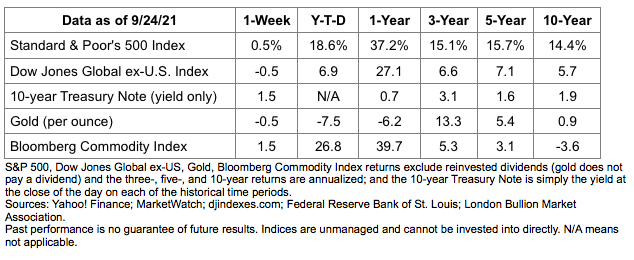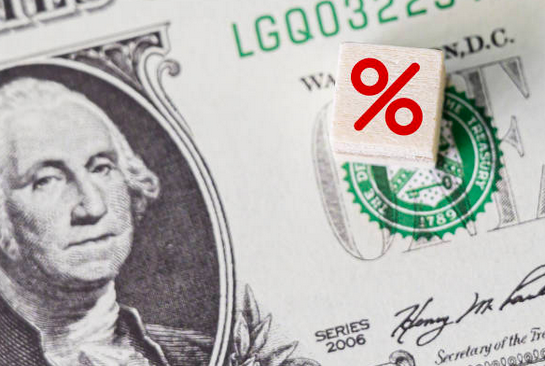Central banks have a lot of influence on investors, markets and economies.
For the last year or so, the Federal Reserve has been purchasing $120 billion of bonds every month to ensure United States markets remained liquid and interest rates remained low during the pandemic. Last Wednesday, the Fed announced that it is ready to begin to buy fewer bonds, a process known as tapering. The Fed’s taper is expected to begin before year-end. The Fed is not expected to push interest rates higher for some time so, overall, monetary policy will continue to support economic growth.
On Thursday, the Bank of England (BoE) said it expects inflation to exceed 4 percent by the end of the year. That’s twice the BoE’s target inflation rate. After the statement was issued, one measure of investors’ expectations priced in “…a 90 percent chance that the BoE would raise rates by February [2022], up from just over 60 percent before – though some economists say this is premature given the challenges to growth,” reported David Milliken and Andy Bruce of Reuters.
Expectations that central bank policies will soon be less accommodative caused yields on 10-year government bonds in the United Kingdom and the United States to rise. “Surging long-term bond yields put an outsized dent into valuations for growth companies because those firms are valued on a relatively long-term basis,” reported Nicholas Jasinski, Jacob Sonenshine and Jack Denton of Barron’s.”
While rising yields can negatively affect equity valuations, they may not hurt share prices if company earnings continue to grow and investors’ appetite for equities remains strong, reported Sean Markowicz of Schroders.
Concerns about less accommodative monetary policy may be less pressing than worries about the health of China’s financial system. The People’s Bank of China injected cash into its banking system again last week to reassure investors after a large Chinese company missed a bond payment deadline, reported Anshuman Daga, Andrew Galbraith and Tom Westbrook of U.S. News & World Report.
After a sharp sell-off early last week, major U.S. stock indices finished the week flat to slightly higher, reported Barron’s. The yield on 10-year U.S. Treasuries rose.

Banned In China
China has been trying to limit cryptocurrencies for a long time without much success. In 2019, cryptocurrency trading was banned; however, the practice persisted. Earlier this year, the Chinese government restricted banks and payment companies from providing services related to cryptocurrency transactions and warned buyers they would have no protection if they traded cryptocurrencies, reported the BBC.
Last week, China banned all cryptocurrency transactions and announced that ten regulatory agencies will work together to enforce the ban, reported Alun John, Samuel Shen, and Tom Wilson of Reuters.
Cryptocurrency is “any form of currency that only exists digitally, that usually has no central issuing or regulating authority but instead uses a decentralized system to record transactions and manage the issuance of new units, and that relies on cryptography to prevent counterfeiting and fraudulent transactions,” according to Merriam Webster.
China also banned cryptocurrency mining. Unlike many types of money, cryptocurrency is not issued by a nation’s central bank. It is mined using an energy-intensive process that “relies on many distributed computers verifying and checking transactions on a giant shared ledger known as the blockchain,” reported the BBC. Prior to the ban, China was one of the world’s largest mining centers because of its relatively low energy costs and inexpensive computer hardware.
The ban doesn’t mean China won’t have digital currency. China’s central bank is developing an official digital currency that is being tested now and is expected to be introduced more widely next year. “The ban on crypto appears designed to build support for the official digital currency while signaling to Chinese residents that financial transactions must be traceable and won’t be tolerated on decentralized blockchains,” reported Daren Fonda and Joe Woelfel of Barron’s.”
The United States also is considering how to regulate cryptocurrencies.
“If a business does well, the stock eventually follows.”
—Warren Buffet, investor
Investment advisory services offered through Keystone Financial Services, an SEC Registered Investment Advisor. These views are those of Carson Coaching, not the presenting Representative, the Representative’s Broker/Dealer, or Registered Investment Advisor, and should not be construed as investment advice. This newsletter was prepared by Carson Coaching. Carson Coaching is not affiliated with the named firm or broker/dealer. Government bonds and Treasury Bills are guaranteed by the U.S. government as to the timely payment of principal and interest and, if held to maturity, offer a fixed rate of return and fixed principal value. However, the value of fund shares is not guaranteed and will fluctuate. Corporate bonds are considered higher risk than government bonds but normally offer a higher yield and are subject to market, interest rate and credit risk as well as additional risks based on the quality of issuer coupon rate, price, yield, maturity, and redemption features. The Standard & Poor’s 500 (S&P 500) is an unmanaged group of securities considered to be representative of the stock market in general. You cannot invest directly in this index. All indexes referenced are unmanaged. The volatility of indexes could be materially different from that of a client’s portfolio. Unmanaged index returns do not reflect fees, expenses, or sales charges. Index performance is not indicative of the performance of any investment. You cannot invest directly in an index. The Dow Jones Global ex-U.S. Index covers approximately 95% of the market capitalization of the 45 developed and emerging countries included in the Index. The 10-year Treasury Note represents debt owed by the United States Treasury to the public. Since the U.S. Government is seen as a risk-free borrower, investors use the 10-year Treasury Note as a benchmark for the long-term bond market. Gold represents the 3:00 p.m. (London time) gold price as reported by the London Bullion Market Association and is expressed in U.S. Dollars per fine troy ounce. The source for gold data is Federal Reserve Bank of St. Louis (FRED), https://fred.stlouisfed.org/series/GOLDPMGBD228NLBM. The Bloomberg Commodity Index is designed to be a highly liquid and diversified benchmark for the commodity futures market. The Index is composed of futures contracts on 19 physical commodities and was launched on July 14, 1998. The DJ Equity All REIT Total Return Index measures the total return performance of the equity subcategory of the Real Estate Investment Trust (REIT) industry as calculated by Dow Jones. The Dow Jones Industrial Average (DJIA), commonly known as “The Dow,” is an index representing 30 stock of companies maintained and reviewed by the editors of The Wall Street Journal. The NASDAQ Composite is an unmanaged index of securities traded on the NASDAQ system. International investing involves special risks such as currency fluctuation and political instability and may not be suitable for all investors. These risks are often heightened for investments in emerging markets. Yahoo! Finance is the source for any reference to the performance of an index between two specific periods. The risk of loss in trading commodities and futures can be substantial. You should therefore carefully consider whether such trading is suitable for you in light of your financial condition. The high degree of leverage is often obtainable in commodity trading and can work against you as well as for you. The use of leverage can lead to large losses as well as gains. Opinions expressed are subject to change without notice and are not intended as investment advice or to predict future performance. Economic forecasts set forth may not develop as predicted and there can be no guarantee that strategies promoted will be successful. Past performance does not guarantee future results. Investing involves risk, including loss of principal. The foregoing information has been obtained from sources considered to be reliable, but we do not guarantee it is accurate or complete. There is no guarantee a diversified portfolio will enhance overall returns or outperform a non-diversified portfolio. Diversification does not protect against market risk. Asset allocation does not ensure a profit or protect against a loss. Consult your financial professional before making any investment decision. Please contact our office if you would like a list of sources used in creating this content.
